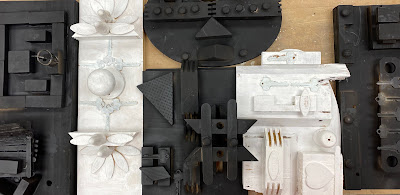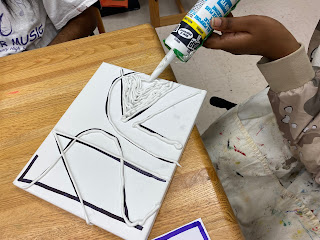The ten minute drive made for a quick field trip, but I think our students were happy to experience a wide range of displays and a personal tour by our very own French teacher.
Wednesday, September 28, 2022
My Journey In Art Exhibition
Friday, September 23, 2022
Relief Sculpture with Found Objects
Saturday, September 10, 2022
Caulk Painting
Hammer and nails, drill and screws, and now caulk. We're exploring lots of media, tools, techniques, and procedures in Art this month.
I've noticed lots of problems in understanding how to make an effective composition, so I had to lay down some guidelines for this one. Each student had to fill the canvas by using large, medium and small shapes, coming in from the edges. Most students created eight to twelve shapes by overlapping some lines.
Then they filled most of the shapes with a variety of textures by using the caulk to make dots, circles, spirals, dots and spirals. the next day we played around paints.
Friday, September 9, 2022
String Art
My students love string art. Stitching yarn in a board is therapeutic and the end product is a tactile image, something that they appreciate, since they are visually impaired.
Students place shapes on the back of a piece of matboard, and then went around the shapes using a thumb tack. The wholes were too small for our big plastic needles, so they placed the mat on a wooden bored and punched each hole with a hammer and nail. This was a great chance to practice using the world's favorite building tool.Screw Art






















